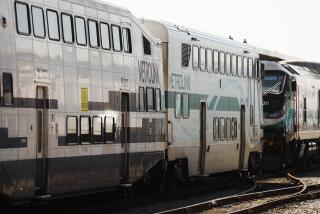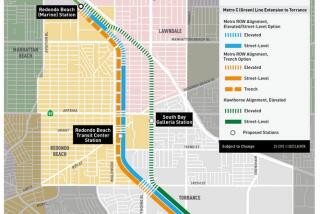Metrolink Ought to Make Fences, Not Excuses
The Metrolink commuter train approaches 13th Avenue in Upland with hardly any warning as it heads toward Los Angeles.
The horn sounds three times before the train rounds a long curve. But the train, blocked from view by a tree, isnât visible until it reaches a straightaway stretch of track.
On Friday morning, as I watched from 13th Avenue, the train sped by so quickly, so unexpectedly, that I was caught by surprise. There was no way Alexes Robles, 3, and her 22-month-old sister, Deziree Soto, could have escaped the train after they wandered onto the tracks Tuesday morning.
Nor was there any obstacle to deter the children from reaching the tracks. A gentle slope leads to the tracks, which are raised a few feet above street level. Itâs an easy climb, even for a toddler.
There was a tall wire fence to the left of the tracks designed to keep people away from a flood control drain. Obviously, the San Bernardino County Flood Control District, which installed the fence, has recognized the hazards posed by the facility in such a populous area.
I was angry, as anyone else would be who saw how easy it was for the girls to wander onto the tracks, and how impossible it would be for them to escape once the train sounded its horn and loomed into view.
*
The fact is, money is available to fence the tracks in residential areas. But the officials who run the transportation system lack the political will, creativity and brains to put the funding together.
Instead, the Southern California Regional Rail Authority, which runs the Metrolink commuter trains, relies on education, refusing to fence dangerous tracks except in response to public pressure in the Sylmar-Pacoima area of the San Fernando Valley. âOur position is that the only true solution is to eliminate trespassing on rights of way through an ongoing educational program,â spokesman Francisco Oaxaca told me.
What a dumb idea. When he told me that, all I could think of was how educational programs have failed to stop teenage smoking, not to mention teenage sex and drug abuse.
Dana Reed, one of the stateâs most experienced transportation officials, explained the financial situation to me.
Reed, an attorney, knows what he is talking about. He was undersecretary of the Business and Transportation Agency under Gov. George Deukmejian. He is a former board member of the Southern California Regional Rail Authority. And he is now on the California Transportation Commission, the agency that decides state transportation policy and allocates funds.
Reed said there are federal and state funds--in the $4.9-billion State Transportation Improvement Program--available to fence commuter tracks in all residential areas throughout the 416-mile system. Metrolink on Sunday began to fence only a mile around where the girls were killed.
The California Transportation Commission distributes the money to various projects around the state.
âThis is not rocket science,â Reed said. âCaltrans has been fencing the freeways for years. The idea of keeping people away from moving machines is not a new idea. This has got to stop. This is not debatable.â
*
Looking at the tracks in Upland, I couldnât help think about the way these deaths are intertwined with the story of Southland transportation.
The tracks once carried Southern Pacific freight trains through the ranchlands of the Inland Empire. Now, they are part of the Metrolink system, a network of commuter rail that extends from Union Station in Los Angeles northwest to Oxnard, north to Lancaster, east to San Bernardino and Riverside and south through Orange County.
Most of the commuter lines run on tracks laid by railroad companies before the Southland became a huge suburb. Using the old tracks made the commuter network affordable. But, because of Metrolinkâs failure to spend money for fences where the tracks edge close to homes and children, two little girls died last Tuesday in an accident that was completely preventable.
Now is the time to fix it. Gov. Pete Wilson could tell his appointees on the state Transportation Commission to spend some of the money for fences. The local officials on the Metrolink board should demand this. None of this has happened.
Our hearts were touched by the deaths of Alexes Robles and Deziree Soto. But the fact is 12 other people have been killed on Metrolink tracks this year. Unless Wilson, the Transportation Commission and the Metrolink board act, many more will die.
More to Read
Sign up for Essential California
The most important California stories and recommendations in your inbox every morning.
You may occasionally receive promotional content from the Los Angeles Times.










